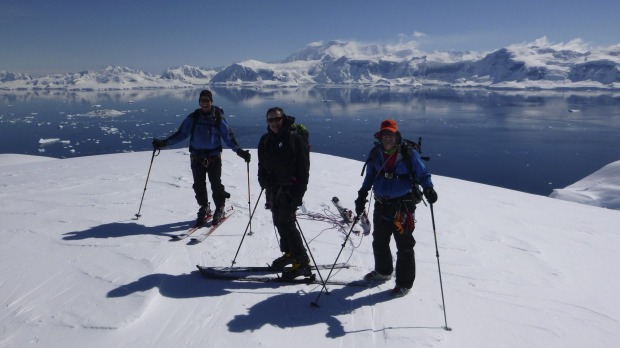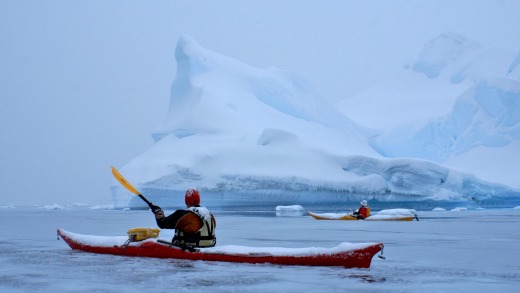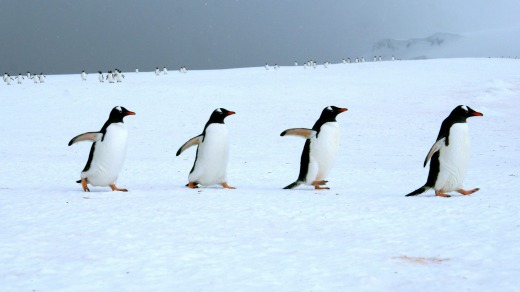
Our timing could not have been better. For the first time, after several months at sea, hundreds of penguins are stepping their weary webbed feet upon land on the very same day as the 50 passengers aboard the Akademik Ioffe. It's the first voyage of the Antarctic season; however, we are not supposed to be here.
The original plan was to visit another part of the South Shetland Islands, but conditions were too choppy, so the captain decided to shift the ship along to the more protected Yankee Harbour. It seems our slippery new friends had the same idea. And now, right before me, a whole colony of Gentoo penguins is waddling in from the water, forming a queue across the glary snow.
The penguins are immaculate, primped in their black-and-white best.
I lie down in their path, a few metres ahead, and wait for them to walk towards me. While the majority are completely disinterested in my existence, the more curious creatures come up close to stare. Making eye contact with one after the other, with nobody else nearby, is an unexpected wildlife encounter that lasts three long, sweet hours.

Nearer the shore, other people are roaring with laughter at dozens more penguins attempting to jump onto an iceberg. Several at a time, they burst out of the water like popcorn. Most slide back down the wobbling ice and fall off; some misjudge the landing and leap all the way over the top, splashing back into the sea. Their clumsiness is so comical that they seem fraudulent as marine birds.
In the distance, six skiers are heading off to find a suitable slope. The Ioffe is the only ship to take passengers skiing this year, so even some of the Gentoos seem intrigued by this strange spectacle. Antarctica, the ultimate polar playground, is utterly surreal.
But for the new residents, these enchanting scenes are serious business. As the start of breeding season, this is a crucial time for these penguins to secure the best place to nest, which increases one's chances of luring a mate and ensuring your chicks survive the harsh conditions.

We leave the freshly forming community to get on with its mission, returning to our Russian-flagged ice-breaker, which operates as a polar research vessel in winter. The drab exterior belies the buzzing excitement within, as everyone squeals about their once-in-a-lifetime dream come true. We made it, and we got lucky.
The ship's naturalist, Brian Keating, an anthropology professor at the University of Calgary, is the most ecstatic. He can't get over the coincidence of reaching the colony on the same day as the penguins, to witness the sea-to-shore procession in motion. Earlier in the day, over breakfast, he had warned us that it was unlikely we would see much wildlife.
Also onboard, a television producer from Animal Planet says the film crew recorded enough incredible footage this morning to create their entire documentary. "We could literally pack up and go home today," he says, beaming.
The first week of November is not exactly prime time for tourists to go to Antarctica. The truth is the 96-passenger Ioffe is half-empty. Most cruisers come in January or February, when the weather is warmer and more whales have made their way south. However, the problem with the late season is that thousands of people, not to mention penguins, have come before you. By new year, the snow is stained pink from penguin droppings and the stench can be noxious.
But in November, the penguins are immaculate, primped in their black-and-white best. The landscape is virginal, cleansed by the winter snowfall. A white carpet awaits. As our boots crush fresh footprints into the sacred ground, we feel like pioneers in an undiscovered land.
The next day, our trailblazing backfires. When we attempt to hike up a mountain, untouched by humans for at least nine months, our guide struggles to forge a safe path. We are forced to stop and start, waiting as he digs the next section of a track for us to follow. After an hour of balancing on a narrow ridge in icy winds, we abandon the summit halfway up.
I have primarily come on this trip for its overnight kayak and camping expedition, but when I see how quickly the weather changes, I start having second thoughts. Then I find out I'm the only crazy fool who has signed up to do it. Secretly, I'm hoping the crew won't bother to proceed with the plan for just one person – but no, they're totally game.
The cruise also offers daytime kayaking, and there's only 15 people in our group. Wearing six layers of clothes, two pairs of gloves, a drysuit, lifejacket and rubber booties, I am paired up with Jana, an athletic German girl who looks like she's used to this sort of caper. Jana volunteers to come on the overnight kayaking with me, so now there are no excuses. Gulp.
The kayakers starts off slowly with an afternoon paddle, led by three guides, in a bay littered with bergy bits. The murky, grey sunlight suddenly dims as it starts to snow, turning the atmosphere eerie. It's a far cry from canoeing off a beach in a bikini, but absolutely magical.
The water is so slushy, it's like paddling through porridge. As we plough our way through, I imagine we're navigating a massive frozen margarita. Snow piles up on my hat and shoulders and frosts my eyelashes. Not even the seals have come out to play in these conditions, but it's an unforgettable experience.
Each day the kayaking is different. In Paradise Harbour, the blue sky and sun come out, illuminating the icebergs into dazzling white palaces. On one afternoon, we spot leopard seals and a minke whale. For our last outing, we confidently hit the open sea, surfing along waves next to playful chinstrap penguins.
In the end, the overnight expedition never happens due to "unpredictable conditions". By now, my feelings have flipped and I am gutted to miss out on the adventure – a total turnaround in less than a week. In Antarctica, you learn quickly, nothing is predictable.
During our voyage, the Akademik Ioffe's expedition leader Aaron Lawton was charged by a leopard seal – an extremely rare event. Standing on the shore, Aaron was splashing the shallow water to imitate a penguin, joking that it would attract seals. Suddenly, a three-metre spotted leopard seal, with a face like an angry lizard, made a sharp left turn and leapt out of the water towards him. Although it fell short of a direct attack, the seal gave Aaron "the most malevolent look I've ever seen" before turning back to the water.
There are only three well-known cases of leopard seal attacks on humans. The most notable incident involved a member of Sir Ernest Shackleton's expedition of 1914–1917, Thomas Orde-Lees, who was chased while camping on the ice. He was saved only when one of the crew shot the seal.
In 1985, Scottish polar explorer Gareth Wood also had a close call while walking on Antarctic land. A leopard seal suddenly crashed up through a thin layer of ice and grabbed his leg in its powerful jaws. Wood's companions had to repeatedly kick the seal's head with their spiked crampon boots before it let go.
A British marine biologist, Kirsty Brown, 28 is thought to be the only human killed by a leopard seal, as she snorkelled near Rothera research station in 2003. Scientists fear that the greater exposure to growing numbers of people in Antarctica is causing leopard seals to assess humans as prey.
Leopard seals have also been known to attack inflatable boats, like those favoured by cruise ships for sightseeing and shore excursions. One Ocean Expeditions' zodiacs have several layers so even if the outer shell is punctured, it stays afloat.
LAN operates flights from Sydney to Ushuaia via Santiago.
lan.com
One Ocean Expeditions' 'Antarctica Off the Beaten Track' itinerary attracts younger and more active passengers. On our voyage, ages ranged from 18 to 70, with the vast majority of passengers 30-50 years old, from Canada, Australia, US and Europe.
The next 12-night expedition aboard the Akademik Ioffe, departing Ushuaia, Argentina, November 10, allows activities such as ski touring, overnight camping and kayaking, expedition snowshoeing and field photography with polar photographers.
Triple-share fares start at $9985 person; twin-share fares from $12,600. To book, 1300 368 123, oneoceanexpeditions.com.
activetravel.com.au
The writer was a guest of LAN and One Ocean Expeditions.